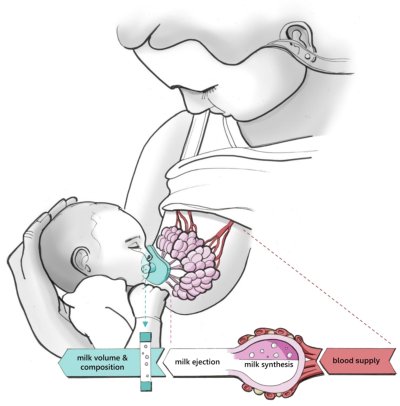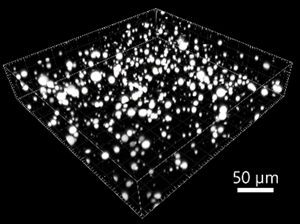Human milk and lactation
I am a student: Bring me to the available projects!
Breastfeeding has unique advantages for mothers and infants: it supports optimal physical and cognitive development, it protects against infections, and it plays an important role in the development of the microbiome. But despite all these benefits, many mothers experience breastfeeding problems, and many aspects of human milk and lactation are not yet completely understood. One of the most frequently occuring complications is low milk supply, or lactation insufficiency. An estimated 10-15% of breastfeeding women fail to produce enough milk, while 40-50% stop breastfeeding because of perceived insufficiency. To address this public health challenge, two key questions need to be solved: |
We develop innovative imaging and sensing technologies to learn more about human milk and the physiology of lactation. Thereby, we aim to obtain more fundamental knowledge about healthy lactation biology and how it changes in case of complications. In turn, this will aid to the diagnosis, treatment and prevention of (perceived) low milk supply. The majority of this research is currently funded by a Starting Grant from the European Research Council (ERC): LactIns-and-outs. |
|
Imaging and sensing technologies
| The techniques that we develop and use to evaluate milk flow and composition include: laser Doppler flowmetry, ultrasound particle image velocimetry (PIV), multi angle light scattering (MALS), 3D-confocal laser scanning microscopy, laser diffraction, Raman spectroscopy, refractometry, flow cytometry, diffuse reflectance spectroscopy (DRS) and spectroscopic optical coherence tomography (sOCT). Ultimately, we aim to use (a selection of) these techniques for the inline quantification of changes in milk flow rate and composition from the mother to the infant. |
| Techniques that we use to evaluate lactating breast biology include: diffuse optical spectroscopy (DOS), laser Doppler perfusion monitoring (LDPM) and magnetic resonance imaging (MRI). With these techniques, we aim to learn more about how different aspects of mammary physiology (i.e. hemodynamics, tissue composition, metabolic activity, milk ejection) regulate milk supply. |
team
ALUMNI AND FORMER TEAM MEMBERS
PhD Students
- 2020 - Dr.ir. Colin Veenstra
Master Students
- 2022 - Hanne van der Glind | Applied Physics
- 2021 - Miriam van der Hoek | Biomedical Engineering
- 2020 - Hanna de Wolf | Biomedical Engineering & Applied Physics
Bachelor Students
- 2024 - Rozan Gierveld | Biomedical Engineering
- 2024 - Lonneke Heerkes | Biomedical Engineering
- 2024 - Eva Mulders | Biomedical Engineering
- 2024 - Vera Lammens | Biomedical Engineering
- 2024 - Chris Legtenberg | Biology and Medical Laboratory Research - Saxion Hogeschool
- 2023 - Kawthar Ali | Biology and Medical Laboratory Research - Saxion Hogeschool
- 2023 - Liselotte Bokma | Applied Physics
- 2022 - Puck van de Beek | Biomedical Engineering
- 2022 - Richelle Michorius | Biomedical Engineering
- 2020 - Rachel Foppen | Biomedical Engineering
- 2018 - Anki Lenferink | Biology and Medical Laboratory Research - Saxion Hogeschool
- 2018 - Miriam van der Hoek | Biomedical Engineering
- 2017 - Gerhard Berman | Biomedical Engineering
Researchers
- 2019 - MSc. Dayna Every
SELECTED PUBLICATIONS
- J.R. de Wolf, K. Ali, C.G. Legtenberg, W. Verveld, N. Bosschaart, The refractive index of human milk serum: natural variations and dependency on macronutrient concentrations, Foods 13(24), 4124 (2024), doi: https://doi.org/10.3390/foods13244124
- W. Verveld, J.R. de Wolf, C.G. Legtenberg, T. Knop, N. Bosschaart, Human milk fat globule size distributions: comparison between laser diffraction and 3D confocal laser scanning microscopy, Food Research International 198, 115282 (2024), doi: https://doi.org/10.1016/j.foodres.2024.115282
- A. Boamfa, C. Coverstone, O. Abdalsalam, A. Flavia de Almeida Barreto, A. Wei, J.R. de Wolf, S.M. Schoustra, T.D. O’Sullivan, N. Bosschaart, Diffuse Optical Spectroscopy of lactating and non-lactating human mammary physiology, Biomedical Optics Express 15(9), 5429-5441 (2024), doi: https://doi.org/10.1364/BOE.527944 (selected for Spotlight on Optics)
- N. Bosschaart, S.M. Manohar, New directions for optical breast imaging and sensing: multimodal cancer imaging and lactation research, Current Opinion in Biomedical Engineering, accepted for publication (2022), doi: https://doi.org/10.1016/j.cobme.2022.100380 (invited)
- J.R. de Wolf, A. Lenferink, A. Lenferink, C. Otto, N. Bosschaart, Evaluation of the changes in human milk lipid composition and conformational state with Raman spectroscopy during a breastfeed, Biomedical Optics Express 12(7), 3934-3947 (2021), doi: https://doi.org/10.1364/BOE.427646 (editors pick)
- C. Veenstra, D. Every, W. Petersen, J.B. van Goudoever, W. Steenbergen, N. Bosschaart, Dependency of the optical scattering properties of human milk on casein content and common sample preparation methods, Journal of Biomedical Optics 25(4), 045001 (2020), doi: https://doi.org/10.1117/1.JBO.25.4.045001
- C. Veenstra, A. Lenferink, W. Petersen, W. Steenbergen, N. Bosschaart, Optical properties of human milk, Biomedical Optics Express 10(8), 4059-4074 (2019), doi: https://doi.org/10.1364/BOE.10.004059
- N. Bosschaart, A. Leproux, O. Abdalsalam, W. Chen, C.E. McLaren, B.J. Tromberg, T.D. O’Sullivan, Diffuse optical spectroscopic imaging for the investigation of human lactation physiology: a case study on mammary involution, Journal of Biomedical Optics 24(5), 056006 (2019), doi: https://doi.org/10.1117/1.JBO.24.5.056006
- M. van der Hoek, L. den Haan, A. Kaspers, W. Steenbergen, N. Bosschaart, Cutaneous perfusion of the human lactating breast: a pilot study with laser Doppler perfusion monitoring, Physiological Measurement 40(5), 05NT01 (2019), doi: https://doi.org/10.1088/1361-6579/ab1ad7



